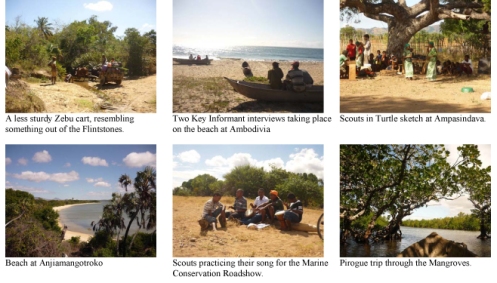Following completion of my Biological Sciences degree in 2010 and fieldwork in Mozambique and Ghana, I spent 3 months as an intern with C3 Madagascar in summer 2011. This is a blog about my experience here; what I did, the highs and the (very few) lows.
There were a number of different projects running during my internship, and I was fortunate to be able to take part in all of them. In all, I spent seven and a half weeks in the office in Diego, six weeks on field trips (one of which was a marathon five weeks long) and had six weekends free to explore the beaches and national parks of the region (Ankarana, Montagne d’Ambre, Montagne des Francais, Ramena and the Emerald Sea). As is the case with the majority of interns, my first week was spent reading up on C3′s research in preparation for the literature test which must be passed before work can begin. I was then given a couple of lectures to write for the Marine Resources Centre (MRC) which C3 runs on Friday afternoons at the University of Antsiranana. Interns are welcome to go along to the lectures and assist with the English lessons which precede them.
The second project I assisted with was the Marine Conservation Roadshow with the Antsiranana boy scouts, which C3 took to a couple of small fishing communities. They performed a series of short sketches, which I helped write and make the costumes for. The performances aimed to highlight the threats facing Sea Turtles, Dugongs and Sharks. I accompanied the scouts on their weekend trip to Ampasindava, part of the Nosy Hara Marine Park on the west coast, taking photos and videos for them to show at the Volvo Adventure Awards in Sweden; where they were finalists in June. When the scouts left on the Sunday morning, I stayed in Ampasindava to take part in the sea turtle nesting tracks monitoring programme, which involved visiting two of the islands in the Nosy Hara Archipelago to count, measure, photograph and mark all the turtle nests and tracks on the beaches. The islands are incredibly beautiful, and on the day I went out we saw dolphins, turtles and nearly an elusive dugong! On the same field trip, a couple of Masters students were interviewing shark fishermen for their dissertations, but unfortunately no fishermen came in on the day I spent waiting on the beach for them.
For most of my time in Madagascar I was involved in the preparation and data collection for the SocMon project; an assessment of the socioeconomic needs of coastal communities in the north east of Madagascar. I spent five weeks traveling the coast from Sambava to Ambolobozokely in five taxibrousses, three pirogues, two boats and walking behind six zebu carts, visiting 25 villages, cooking over wood and charcoal fires and sleeping in accommodation varying between tents on a beach, school house floors and a very generous woman’s bed (and yes, she was sleeping in it at the same time, as was another intern, but it was the best three nights sleep I had on the whole trip!) The interviews we carried out were fascinating, the places we visited were beautiful, and everyone we met was welcoming and eager to talk to us, all of which meant that the lack of running water, electricity, ‘normal’ toilets and showers, the slow and often uncomfortable transport and days of rice and beans three times a day were easily compensated for.
There were countless animals to be seen; lemurs, chameleons, bright green geckos, snakes, birds, turtles, sharks (admittedly dead…) and even a frog brightening up the inside of a particularly cramped cab of a taxibrousse at 3am. Similarly, for every meal of rice and beans, there was one of freshly caught fish or kindly donated pumpkin, the excitement of seeing vegetables again for the first time in days when we got nearer to bigger roads, and the delicious chicken which was killed for my birthday dinner. On long walks behind slow, rickety and slightly out of control zebu carts there was always something to look at; vanilla, coffee and coconut plantations, rice paddies, primary forest, mangroves, rivers, estuaries and villages. Buckets shower in cobwebby shacks over long drop toilets were made up for by bucket showers behind a tree under the stars and the milky way.
I had the opportunity to work on so many different projects (it really depends on what’s going on while you’re here and how many other interns there are for the work to be shared between) and that I got to see so much of Madagascar (although Diego is a great place to live as well, with plenty of bars and restaurants to visit, as well as the more typically Malagasy markets).
I came to Madagascar wanting experience of conservation with small communities in a developing country, and that’s what I’m going home with. What’s more, I got to work with some fantastic people, visit amazing places and experience a new culture. I would recommend an internship here to anyone who has patience and is willing to adapt to unpredictable circumstances and life at a different pace; mora mora as they say in Malagasy


